The highs and lows for 2023 include:
· Bait ball feeding frenzies dominated by Atlantic bluefin tuna, humpback & fin whales
· First ever Highly Protected Marine Areas designated in the UK
· Danger from human disturbance, pollution and avian flu
Humpback whale (c) Richard Shucksmith/scotlandbigpicture.com
The highs and lows for 2023 include:
· Bait ball feeding frenzies dominated by Atlantic bluefin tuna, humpback & fin whales
· First ever Highly Protected Marine Areas designated in the UK
· Danger from human disturbance, pollution and avian flu
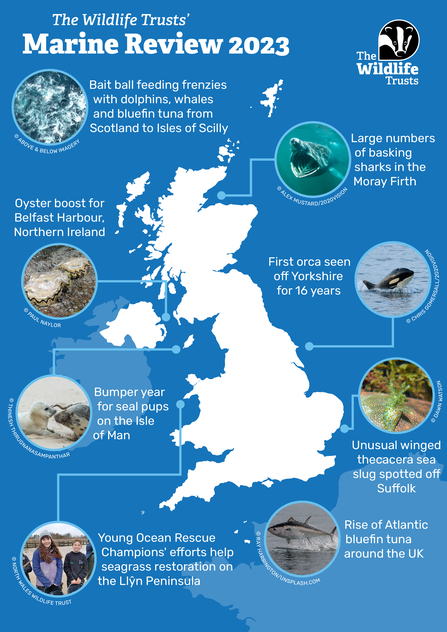
The Wildlife Trusts' Marine Review Map 2023 © The Wildlife Trusts.jpg
Dr Lissa Batey, head of marine conservation at The Wildlife Trusts, says:
“2023 has been a historic year for marine conservation with the creation of the first Highly Protected Marine Areas in English waters. This is a huge milestone which was achieved thanks to years of campaigning by our sea-loving supporters. This new gold-standard of protection will stop all damaging activities such as trawling and enables marine wildlife to recover, benefiting fishers and carbon storing habitats. These special places cover less than half a percent of English seas – so it’s a tiny first step towards more designations.
“Regulation is vital for protecting the natural world and reversing wildlife declines. The end of commercial whaling has brought humpbacks and fin whales back to UK waters, and measures to protect bluefin tuna has led to a spike in sightings. This fantastic fish has returned from the brink of extinction and the risk of decimating the population for a second time remains high – so it is vital that commercial fishing quotas are set realistically and rigorously enforced. When we give nature space, wildlife can recover – it’s as simple as that. We must act faster to protect the UK target of 30% of seas by 2030.”
Nia Hâf Jones, Living Seas Manager at North Wales Wildlife Trust says:
"2023 was one of our busiest yet and it's been a fantastic to see so many people from the local and visiting community showing so much dedication for caring for our marine environment. We had a great year, kicking off with over 150 people coming along to our awesome annual Plast Off! beach clean in January – clearing over a ton of litter from beaches on the west coast of Anglesey in just one day. In April, our Seagrass Ocean Rescue Champions received honourable green Blue Peter badges when they appeared on the show, explaining all about planting seagrass seeds and then, in November, our young Ocean Rescue mentors were awarded North Wales Wildlife Trust’s Volunteer Group of the Year! Throughout 2023, our Shoresearch volunteers spent over 500 hours monitoring our shores, we pushed for sustainable development at sea and topped off the year with Project SIARC winning the National Lottery Wales Project of the Year. I'm looking forward to seeing what 2024 has in store!"
Sea champions
· Young Ocean Rescue Champions and Mentors from Anglesey received honourable green Blue Peter badges for contributing to efforts to collect a million seagrass seeds for a large restoration project on the Llŷn Peninsula.
UK marine conservation would not be possible without the support of fantastic staff and volunteers. Here are The Wildlife Trusts’ 2023 marine award winners:
· Marsh Charitable Trust Volunteer Award for Marine Conservation went to Charlotte Cumming who volunteers for Cornwall Wildlife Trust and has single-handedly validated all 4000 Cornish marine life records. The amazing Donna Nook grey seal colony volunteer monitoring group also won the award.
· Marsh Charitable Trust Young Volunteer Award for Marine Conservation went to Arun Curson, the youngest marine champion at Hampshire & Isle of Wight Wildlife Trust, and to Josh Symes has been an invaluable member of the Cornwall Wildlife Trust’s Shoresearch.
· Lifelong naturalist Rosemary Parslow was awarded The Christopher Cadbury Medal having volunteered with Isles of Scilly Wildlife Trust for over 60 years.
Bait ball feeding frenzies, dolphin ‘super pods’, whales and seal pups top 2023 sightings
A rise in sightings of Atlantic bluefin tuna, fin whales and humpback whales could be a sign that these species are recovering. There were multiple reports of bait ball feeding frenzies involving whales, dolphin, and tuna – from Scotland to Scilly. A bait ball is formed when a predator forces fish to group together into a dense ball – then gannets, cetaceans and tuna dive in to feed, creating a ‘boiling’ sea of activity.
Atlantic bluefin tuna, which grow to over 10ft and weigh more than 1,000lbs, were once common in UK waters. Overfishing caused numbers to plummet during the 20th century. Sightings became rare and the fish had all but vanished by the 1990s. A 15-year recovery plan launched in 2007 saw numbers improve and eventually, bluefin tuna was removed from IUCN’s Red List of Endangered Species. Witnesses recorded many sightings in 2023 from Devon, Cornwall, Isles of Scilly, Scotland, Alderney to Dorset where the local Wildlife Trust recorded a 9ft-long bluefin tuna washed up at Kimmeridge Bay.
Risso's dolphins (c) Ben Stammers
Wildlife enthusiasts were treated to a bumper year for Risso’s dolphins in Cornwall with 156 sightings this year compared to 45 in 2022. There were multiple reports of super-pod feeding frenzies off south-west England, with common dolphins and fin whales joining in.
A bait ball frenzy was witnessed off the island of Coll in the Inner Hebrides of Scotland. A super pod of around 350 common dolphins was joined by up to 10 minke whale and birds such as gannets, manx shearwater, auks, kittiwake, great skua, great northern diver and white-tailed eagles.
A similar event was experienced by Dr Lissa Batey off the Devon coast. She says:
“I went on a family dolphin-watching trip and spotted large numbers of diving gannets. We sailed nearer and as we approached the water appeared to be ‘boiling’ with activity. An extraordinary number of dolphins appeared all around us feeding on a giant fish bait ball below. Bluefin tuna began to leap high out of the water in the middle of the turmoil. Suddenly fin whales appeared and blew high columns in the air before lunging beneath to gorge on the fish. It was an incredibly exciting spectacle and one that I’ve heard other people have enjoyed off the UK coast this summer.”
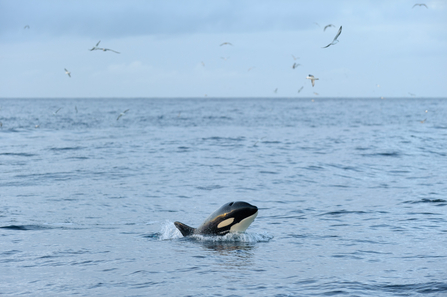
Orca © Chris Gomersall/2020VISION
Other exciting wildlife encounters this year include:
· A male orca was spotted three miles offshore from Bempton Cliffs, Yorkshire. It was the first time an orca has been seen off the county’s coast since 2007.
· Basking sharks gathered in large numbers in the Moray Firth, east Scotland, surprising local people as they are normally spotted only off the west coast.
· A pod of bottlenose dolphins was seen off Norfolk in a rare sighting for the area. The pod had travelled from northern Scotland to Norfolk in 11 days.
· Bumper year for seal pups on the Calf of Man with 94 pups, up from around 65 pups.
· Wildlife watchers were treated to 30 humpback whales throughout this year off Cornwall, the Isles of Scilly and more off Burhou in the Channel Islands. There have been many fin whales recorded around UK coasts, (20+ sightings off Cornwall alone, including 12 in just one event – last year there were less than 5 fin whale sightings) as well as a stranded fin whale at Newquay. In September, a boat tour in Cardigan Bay saw a rare Sowerby's beaked whale – most UK sightings are strandings; these animals have only been seen 13 times in UK waters since 2007.
· Cheshire Wildlife Trust had an exceptional year for natterjack toads, thanks to their careful management of coastal sand dunes. 200 toadlets were found in one day.
· And finally… an unusual, angel-like species of sea slug, the winged thecacera, with orange and black spots, was seen by Seasearch divers off the coast of Suffolk, clinging onto a crab’s shell.
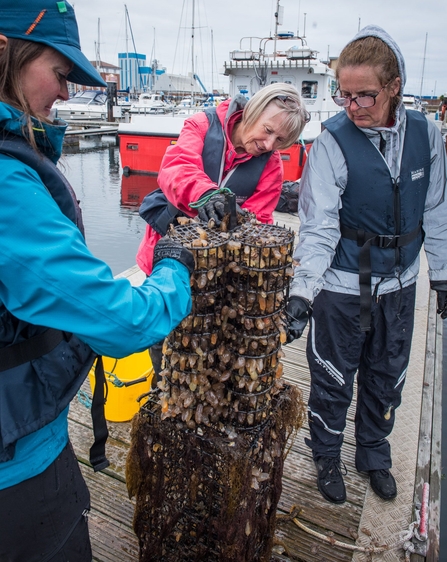
Oyster monitoring at Hartlepool © TEES RIVER TRUST & STRONGER SHORES
New legal protection and marine conservation projects offer hope for the sea
· 2023 was a historic year for marine conservation as the first ever Highly Protected Marine Areas (HPMAs) were designated in English waters. Three places were chosen: Allonby Bay, Cumbria, Dolphin Head, Sussex and North-East of Farnes Deep in the North Sea, are now protected from all damaging activities. The Wildlife Trusts welcome the designations but warn that these only cover 0.4% of English seas – and many more HPMAs are needed to protect marine wildlife and tackle climate change.
· Native oysters were given a boost in Northern Ireland and North-East England:
-Ulster Wildlife and Belfast Harbour created an oyster nursery on the island of Ireland with around 700 native oysters suspended in cages in Belfast Marina. The ambitious project hopes to recover native oysters, which disappeared due to overfishing, pollution and the effect of invasive species. Oysters improve water quality – just one can filter up to 200 litres of seawater a day.
-2023 saw the reintroduction of 10,000 native oyster to a reef off Tyneside.
· Sussex Wildlife Trust and partners helped fishers recycle almost 10,000 kg of old fishing nets, which are being turned into new products. Abandoned fishing gear is a deadly form of marine plastic, threatening two-thirds of marine mammals globally.
· Alderney Wildlife Trust did the first ever surveys of invasive species with official recordings of pacific oysters and devil’s tongue weed around the island. Devon Wildlife Trust also reported problems with the weed. Both species were introduced to the UK in the 1960s.
· Lincolnshire and Yorkshire Wildlife Trusts have been working hard to restore saltmarsh, sand dune and seagrass as part of the Wilder Humber project.
· A report by Cornwall Wildlife Trust and Natural England found that St Austell Bay supports the largest known subtidal seagrass bed in Cornwall – and is one of the largest known seagrass beds in the UK. Seagrass can absorb vast quantities of carbon, but over 90% of UK seagrass has been lost.
· Cornwall Wildlife Trust celebrated the 20th anniversary of its Marine Strandings Network, which records stranded marine wildlife in Cornwall and the Isles of Scilly with the help of over 150 volunteers. The project has positively influenced national and European legislation.
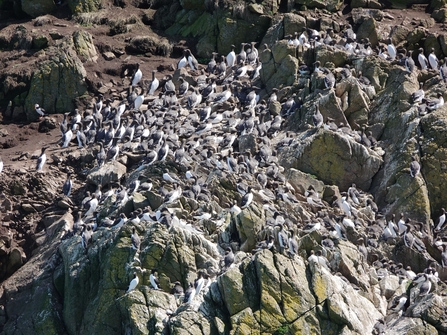
Guillemots on Skomer © D Astins
Avian flu, seabird colonies in trouble, and disturbance and pollution threaten wildlife
The worldwide pandemic of avian flu continued to devastate UK seabirds. While there are signs that some birds are showing immunity, vast numbers were lost including:
· 1,200 dead terns collected at Cemlyn Nature Reserve in North Wales, including over 700 sandwich tern chicks from the only nesting colony in Wales. The colony has roughly halved in size since 2022 due to the disease.
· In Scotland, hundreds of dead seabirds washed up along Aberdeenshire’s coast including kittiwakes, herring gulls and guillemots.
· Over 1000 dead birds were collected from beaches in Pembrokeshire in July.
· Dorset Wildlife Trust recorded 600 dead birds on Brownsea Island during the breeding season, mainly sandwich and common terns, and black-headed gulls.
· On a positive note, external research on Bass Rock suggests that northern gannets with black instead of pale blue irises are more likely to have immunity from the virus.
· Monitoring by Alderney Wildlife Trust suggests there has been no bird flu on the islands this year and around two thirds of breeding gannet pairs successfully fledged chicks.
A seabird survey by the Isles of Scilly Wildlife Trust and RSPB painted a worrying picture for one of the most significant seabird colonies in England. Findings include:
· Overall declines of 20% of seabirds since the last survey in 2015
· A loss of almost half of the islands’ seabirds in the last 30 years
· Common terns lost as an annual breeder, with kittiwakes likely to follow
· Steep declines of the greater black-backed gull, 38%, and lesser black-backed gull, 58%, and the red-listed herring gull, 40%
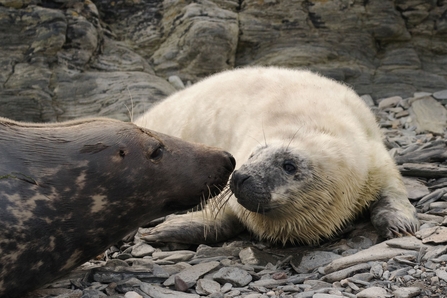
Seal pup and mum, Calf of Man © Lara Howe
Disturbance to seals: Cumbria Wildlife Trust issued a plea for boats to keep their distance from seals following the deaths of some adult grey seals and pups possibly linked with disturbance in north-west England’s only grey seal colony near Barrow. Elsewhere, research found that seal disturbance in Cornwall had increased by around 40% over the last decade.
Pollution from sewage, plastic and industry continues to challenge marine wildlife on shore and at sea. Examples include:
· Tees Valley Wildlife Trust reported thousands of small blue rubber balls washed up on beaches in Teesside. The balls are used in EDF’s power station.
· Nurdles – tiny, raw forms of plastic – washed up on UK beaches, probably spillages from container ships. They can be fatal if eaten by wildlife. Dorset Wildlife Trust reported huge numbers of nurdles at Kimmeridge Bay.
For additional stories and editor’s notes please see: The Wildlife Trusts Marine Review 2023 Trust's Top Stories.pdf